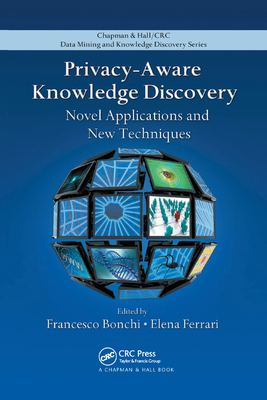Introduction to Privacy-Preserving Data Publishing: Concepts and Techniques (Hardcover)
暫譯: 隱私保護數據發布導論:概念與技術 (精裝版)
Benjamin C.M. Fung, Ke Wang, Ada Wai-Chee Fu, Philip S. Yu
- 出版商: CRC
- 出版日期: 2010-08-11
- 售價: $5,870
- 貴賓價: 9.5 折 $5,577
- 語言: 英文
- 頁數: 376
- 裝訂: Hardcover
- ISBN: 1420091484
- ISBN-13: 9781420091489
-
其他版本:
Introduction to Privacy-Preserving Data Publishing: Concepts and Techniques
海外代購書籍(需單獨結帳)
買這商品的人也買了...
-
 Cisco CCNA (640-802) 最新認證應考手冊
Cisco CCNA (640-802) 最新認證應考手冊$640$506 -
 Visual Basic 2008 程式設計經典
Visual Basic 2008 程式設計經典$650$514 -
 Windows Device Driver Programming 驅動程式設計
Windows Device Driver Programming 驅動程式設計$650$553 -
 MCITP 70-646 Windows Server 2008 Server Administrator 專業認證手冊 (MCITP: Windows Server 2008 Server Administrator Study Guide: (Exam 70-646))
MCITP 70-646 Windows Server 2008 Server Administrator 專業認證手冊 (MCITP: Windows Server 2008 Server Administrator Study Guide: (Exam 70-646))$680$537 -
 巧用 jQuery
巧用 jQuery$490$387 -
 ASP.NET 4.0 專題實務 I─實戰入門篇使用 VB
ASP.NET 4.0 專題實務 I─實戰入門篇使用 VB$750$593 -
 計算機組織與設計 (Computer Organization and Design: The Hardware/Software Interface, 4/e)
計算機組織與設計 (Computer Organization and Design: The Hardware/Software Interface, 4/e)$900$855 -
 前進 Android Market!Google Android SDK 實戰演練
前進 Android Market!Google Android SDK 實戰演練$850$723 -
 ASP.NET 4.0 專題實務 II-範例應用與 4.0 新功能, 2/e
ASP.NET 4.0 專題實務 II-範例應用與 4.0 新功能, 2/e$750$593 -
 Google Android SDK 開發範例大全, 3/e
Google Android SDK 開發範例大全, 3/e$950$808 -
 HTML5: 建置與執行 (HTML5: Up and Running )
HTML5: 建置與執行 (HTML5: Up and Running )$420$332 -
網頁設計師必學 iOS APP—iPhone/iPod touch/iPad APP 設計實戰:使用 HTML5 + CSS3 + JavaScript (The Web Designer's Guide to iOS Apps)
$400$316 -
 學徒模式-優秀軟體開發者的養成之路 (Apprenticeship Patterns: Guidance for the Aspiring Software Craftsman)
學徒模式-優秀軟體開發者的養成之路 (Apprenticeship Patterns: Guidance for the Aspiring Software Craftsman)$420$332 -
 Google!Android 3 手機應用程式設計入門, 4/e
Google!Android 3 手機應用程式設計入門, 4/e$550$435 -
 一定要學會的 HTML5 + CSS3 網頁設計實作應用
一定要學會的 HTML5 + CSS3 網頁設計實作應用$450$351 -
 Eclipse 完全攻略-從基礎 Java 到 PDE 外掛開發
Eclipse 完全攻略-從基礎 Java 到 PDE 外掛開發$600$468 -
 軟體測試專案實作-技術、流程與管理
軟體測試專案實作-技術、流程與管理$520$411 -
 鳥哥的 Linux 私房菜-伺服器架設篇, 3/e
鳥哥的 Linux 私房菜-伺服器架設篇, 3/e$800$632 -
 Google Android 應用程式開發實戰, 3/e (適用 Android SDK 2.x/3.x)
Google Android 應用程式開發實戰, 3/e (適用 Android SDK 2.x/3.x)$680$537 -
 賈伯斯傳 (軟皮精裝版)
賈伯斯傳 (軟皮精裝版)$599$473 -
 Maya 2012 終極密碼
Maya 2012 終極密碼$680$578 -
 Android 技術內幕-探索 Android 核心原理與系統開發
Android 技術內幕-探索 Android 核心原理與系統開發$580$458 -
 Windows Phone 開發實戰 (Beginning Windows Phone 7 Development, 2/e)
Windows Phone 開發實戰 (Beginning Windows Phone 7 Development, 2/e)$680$578 -
 Spring Data 技術手冊 (Spring Data)
Spring Data 技術手冊 (Spring Data)$580$458 -
 Privacy-Preserving Data Publishing: An Overview (Paperback)
Privacy-Preserving Data Publishing: An Overview (Paperback)$1,460$1,387
相關主題
商品描述
Gaining access to high-quality data is a vital necessity in knowledge-based decision making. But data in its raw form often contains sensitive information about individuals. Providing solutions to this problem, the methods and tools of privacy-preserving data publishing enable the publication of useful information while protecting data privacy. Introduction to Privacy-Preserving Data Publishing: Concepts and Techniques presents state-of-the-art information sharing and data integration methods that take into account privacy and data mining requirements.
The first part of the book discusses the fundamentals of the field. In the second part, the authors present anonymization methods for preserving information utility for specific data mining tasks. The third part examines the privacy issues, privacy models, and anonymization methods for realistic and challenging data publishing scenarios. While the first three parts focus on anonymizing relational data, the last part studies the privacy threats, privacy models, and anonymization methods for complex data, including transaction, trajectory, social network, and textual data.
This book not only explores privacy and information utility issues but also efficiency and scalability challenges. In many chapters, the authors highlight efficient and scalable methods and provide an analytical discussion to compare the strengths and weaknesses of different solutions.
商品描述(中文翻譯)
獲取高品質數據是基於知識的決策中至關重要的需求。然而,原始數據通常包含有關個人的敏感信息。針對這一問題,隱私保護數據發布的方法和工具使得在保護數據隱私的同時,能夠發布有用的信息。《隱私保護數據發布導論:概念與技術》介紹了考慮到隱私和數據挖掘需求的最先進的信息共享和數據整合方法。
本書的第一部分討論了該領域的基本原理。在第二部分中,作者提出了針對特定數據挖掘任務的保留信息效用的匿名化方法。第三部分考察了現實且具有挑戰性的數據發布場景中的隱私問題、隱私模型和匿名化方法。雖然前三部分專注於關聯數據的匿名化,但最後一部分研究了複雜數據(包括交易數據、軌跡數據、社交網絡數據和文本數據)的隱私威脅、隱私模型和匿名化方法。
本書不僅探討了隱私和信息效用問題,還涉及效率和可擴展性挑戰。在許多章節中,作者強調了高效且可擴展的方法,並提供了分析性討論,以比較不同解決方案的優缺點。


















